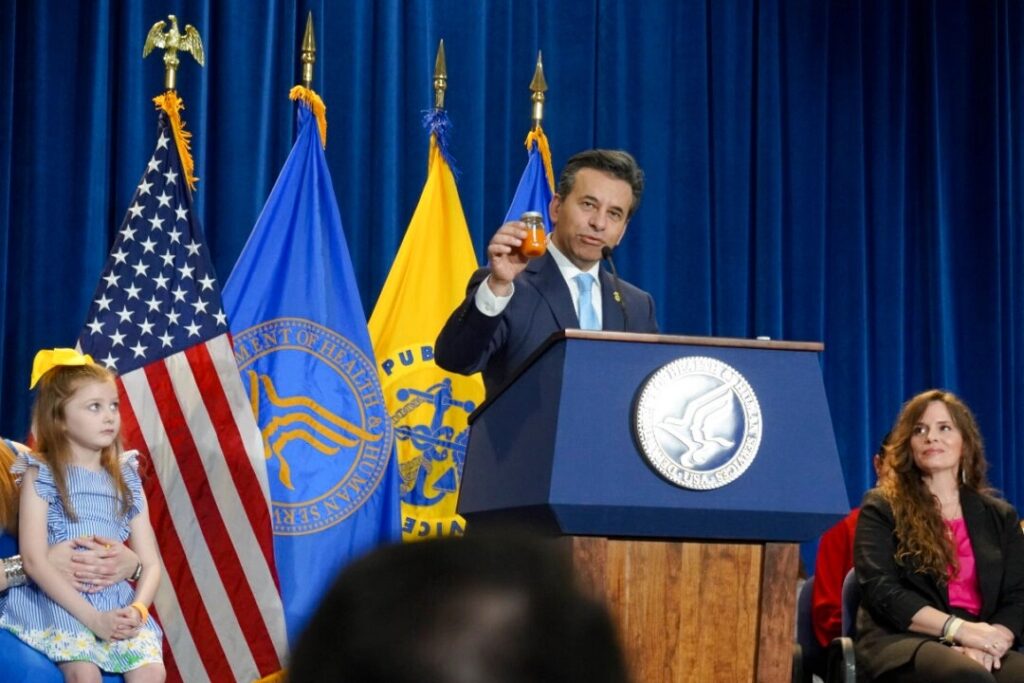
By Ed Malik, A | ed@ddnewsonline.com | posted 24th April, 2025
In a significant move to ensure safety of food and beverages, the United States’ Food and Drug Administration (FDA) on April 22 announced a plan to remove artificial dyes from the nation’s food supply.
Subscribe To The Best Team In Conservative, Business, Technology, Lifestyle And Digital News Realtime! support@ddnewsonline.com
FDA officials said that they are starting with the banning of two synthetic colorings—Citrus Red No. 2 and Orange B, which can currently be used to color hot dogs and sausages—and is going to work with companies to eliminate the other dyes by the end of 2026.
“For the last 50 years, American children have increasingly been living in a toxic soup of synthetic chemicals,” Dr. Marty Makary, commissioner of the FDA, said at a news conference at the Hubert H. Humphrey Building auditorium in Washington.
He cited a randomized trial that found that artificial dyes in the diet resulted in increased hyperactivity in 3-, 8-, and 9-year-olds.

Food and Drug Administration Commissioner Dr. Martin Makary holds up a vial of carrot juice, an alternative to synthetic food dyes, at a press conference at the Hubert H. Humphrey Building in Washington on April 22, 2025. Nathan Worcester/The Epoch Times
Health and Human Services Secretary Robert F. Kennedy Jr. and National Institutes of Health Director Jay Bhattacharya also spoke. Kennedy told a crowd that included Make America Healthy Again (MAHA) Moms that Bhattacharya was investigating various other food additives.
Melissa Hockstad, president and CEO of the Consumer Brands Association, which represents food and drink manufacturers, said in a statement that additives have been studied and demonstrated to be safe.
“We appreciate that the administration has reasserted their leadership in response to the myriad of state activity in the food regulation space,” she added. “A state patchwork of differing laws creates confusion for consumers, limits access to everyday goods, deters innovation, and increases costs at the grocery store.”
The FDA lets manufacturers use nine artificial dyes in food and drinks. Many are made from petroleum. But the agency in January banned one of the dyes, citing concerns about potential carcinogenic effects, but gave food manufacturers until January 2027 to stop using it. Makary said companies should stop using it sooner.
Subscribe To The Best Team In Conservative, Business, Technology, Lifestyle And Digital News Realtime! support@ddnewsonline.com
FDA webpages last updated in 2023 say artificial food additives are generally safe when used in line with FDA regulations.
“The totality of scientific evidence shows that most children have no adverse effects when consuming foods containing color additives, but some evidence suggests that certain children may be sensitive to them,” one page states.
Additives can cause allergic reactions, including itching and hives, another says.
In a meeting earlier this year with executives from PepsiCo, Tyson Foods, and other major food and drink manufacturers, Kennedy instructed them to remove artificial dyes from their foods within two years.
A PepsiCo representative said at the time that the company is “focused on providing consumers with convenient, affordable, and safe foods and drinks—including more options with natural ingredients, no synthetic colors and reductions in sugar, fat, and sodium.”
Kennedy said on April 22, “I want to commend food companies for working with us.”
He also accused the food industry of suppressing research and said that the National Institutes of Health, which, like the FDA, is part of the Department of Health and Human Services, is “narrowly targeting” additives for scientific study.
Subscribe To The Best Team In Conservative, Business, Technology, Lifestyle And Digital News Realtime! support@ddnewsonline.com
Officials said the administration had not yet made a formal deal with food companies on dyes.
“There are a lot of tools at our disposal,” Makary said. “Let’s start in a friendly way.”
Some companies have removed dyes from products in recent years. Kraft, for example, in 2014 swapped artificial dyes in its macaroni and cheese for spices such as paprika and turmeric.
“There’s no one ingredient that accounts for the child chronic disease epidemic, and let’s be honest, taking petroleum-based food dyes out of the food supply is not a silver bullet that will instantly make America’s children healthy,” Makary said. “But it is one important step.”
NOTE: The Epoch Times and Wire sources



Da die Spielbank nahezu wöchentlich mehrere Poker-Turniere veranstaltet,
sollten sich Interessierte rechtzeitig für eine Teilnahme anmelden. Die Einsätze bewegen sich zwischen mindestens 5 bis maximal 1.000 Euro.
Somit werden die Bedürfnisse von risikoscheue
Neulingen und solventen High Rollern bestens gestillt.
Ob bei strahlendem Sonnenschein oder unter dem funkelnden Sternenhimmel,
Valkenburg weiß seine Gäste zu jeder Jahreszeit zu begeistern.
Wenn der Dezember naht und die ersten Schneeflocken fallen, erstrahlt Valkenburg in einem weihnachtlichen Glanz, geprägt von märchenhaften Lichterketten und geschmückten Bäumen. Es
ist eine Zeit des gemütlichen Beisammenseins und der Vorbereitung auf den Weihnachten in Valkenburg, eine Saison, der die Einheimischen und Gäste gleichsam entgegenfiebern. Die Freiluft-Cafés rücken näher zusammen, die Decken werden dicker und
die heißen Getränke dampfen in den Händen der Besucher.
Aber selbst wer ohne zu spielen einfach nur
das besondere und traditionelle Casino-Flair in Bad Ems erleben will,
ist herzlichst eingeladen und willkommen. Dafür trägt auch der Automatenbereich Sorge,
der vom Klassischen Spiel abgetrennt ist und knapp 70 Glücksspielautomaten umfasst.
Das spiegelt sich im überschaubaren Angebot an Casinospielen wider.
Ansonsten müssen hungrige Glücksspieler Vorlieb mit den Restaurant-Alternativen im City Palais nehmen, von denen reichlich vorhanden sind.
Regelmäßig finden Mottopartys oder Veranstaltungen statt wie beispielsweise die Las Vegas Night, Männerabend, Ladies Night, Bingo Spezial oder Live Gameshows auf
der Bühne.
References:
https://online-spielhallen.de/1go-casino-bonus-codes-ihr-umfassender-leitfaden/